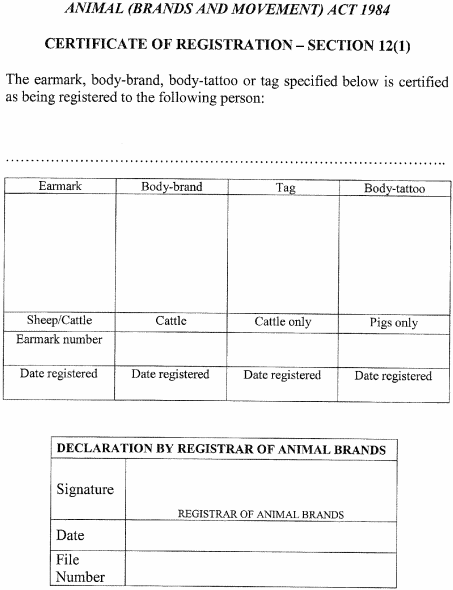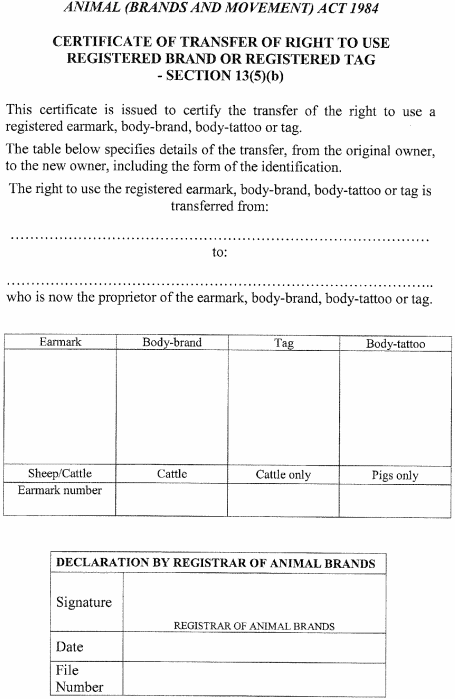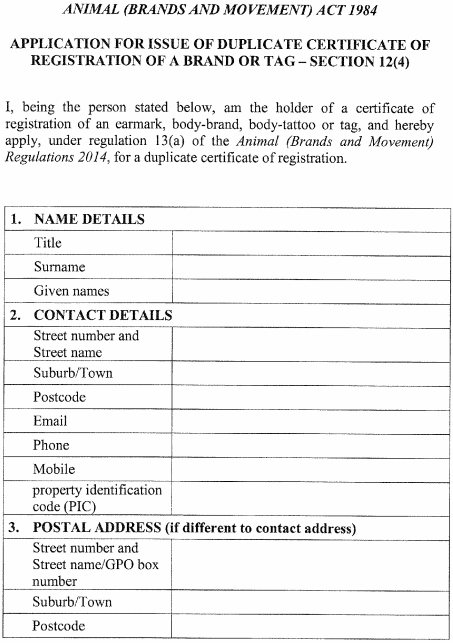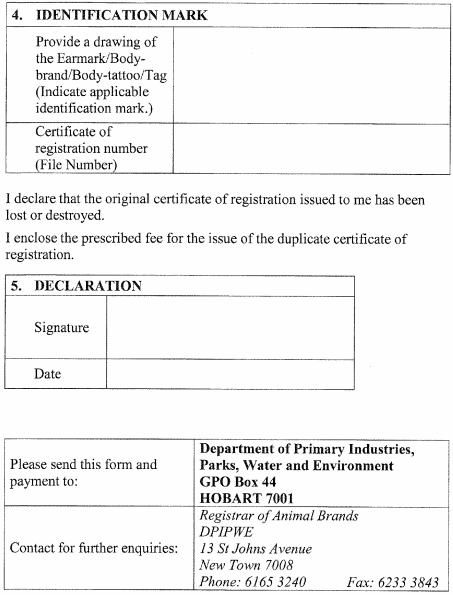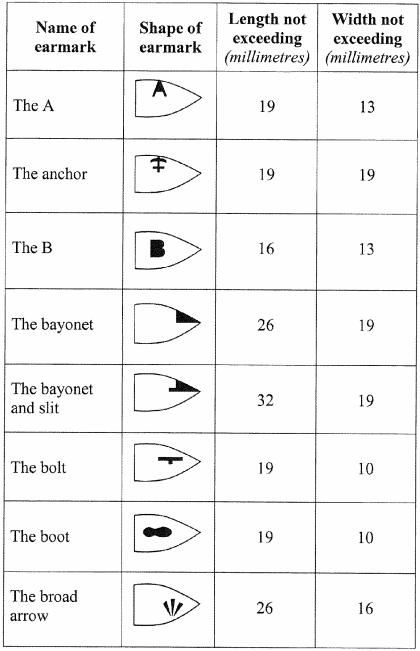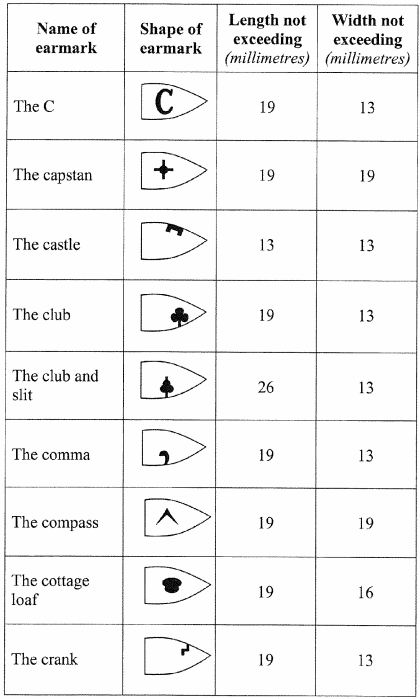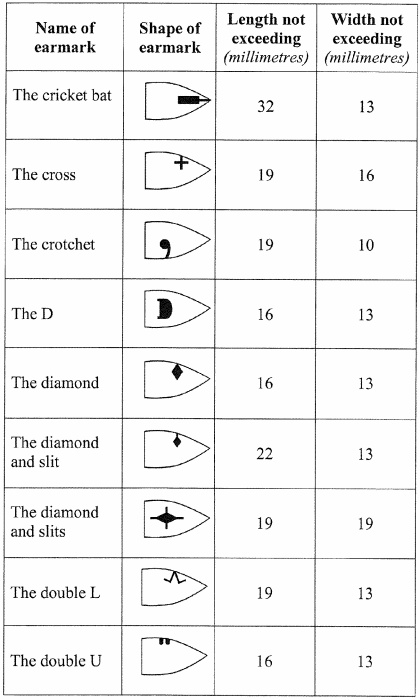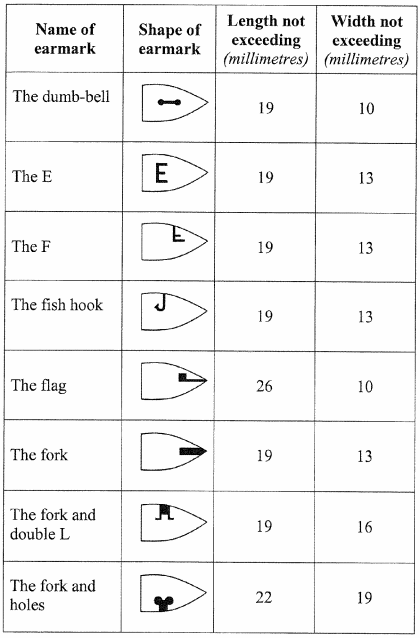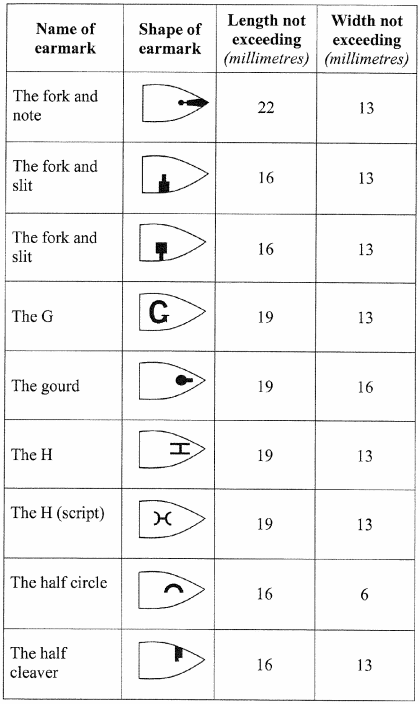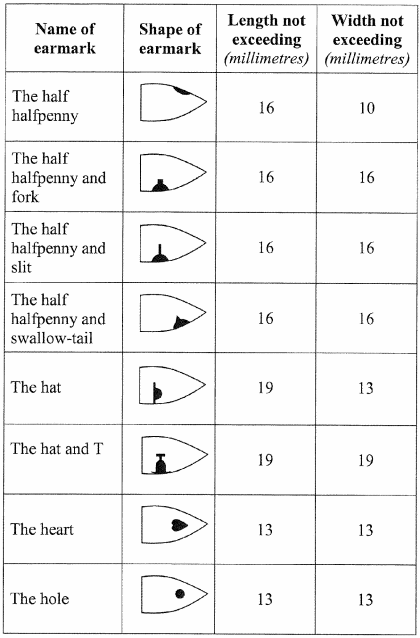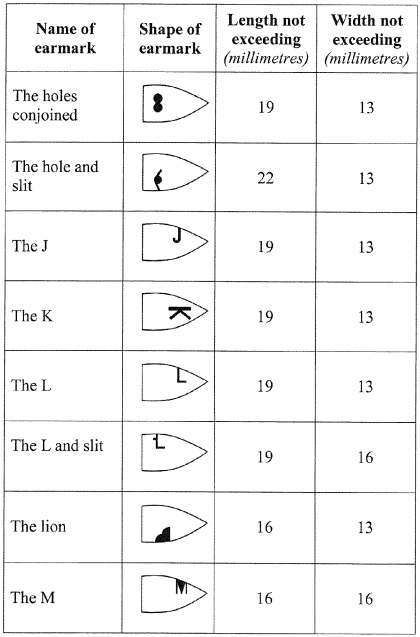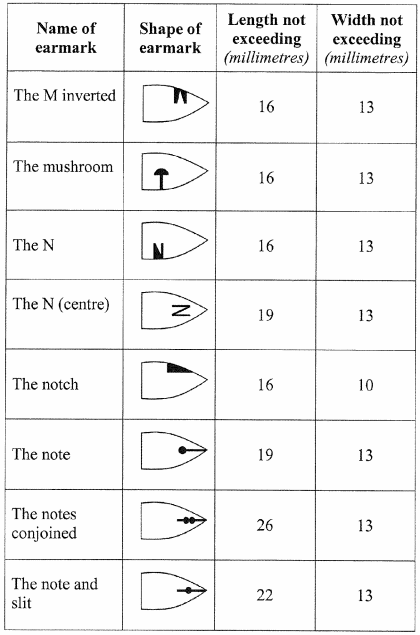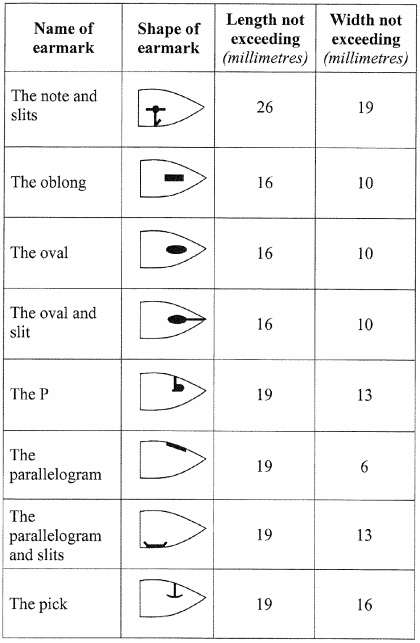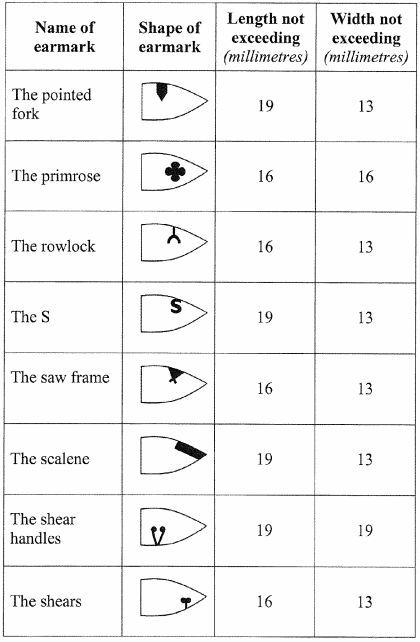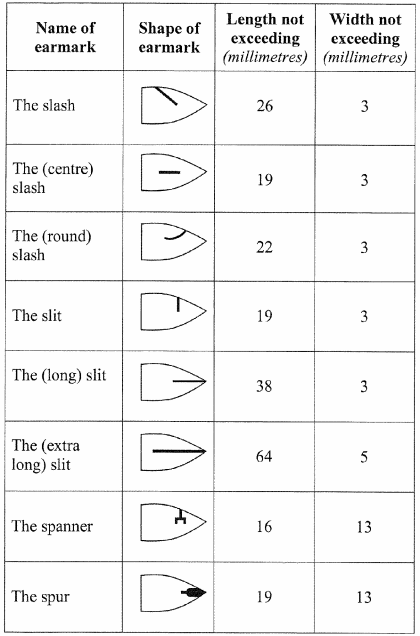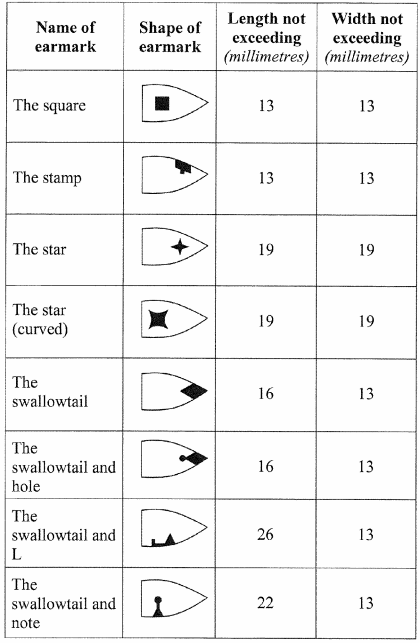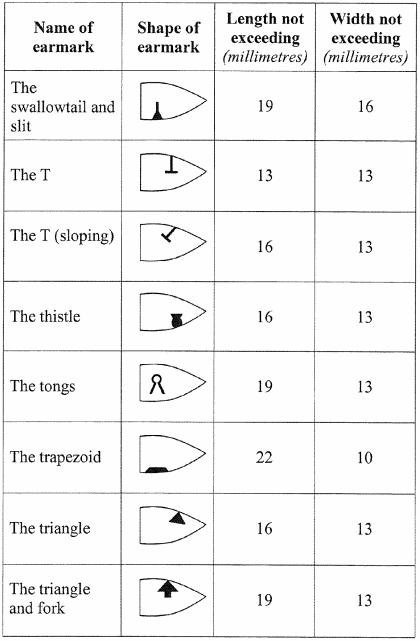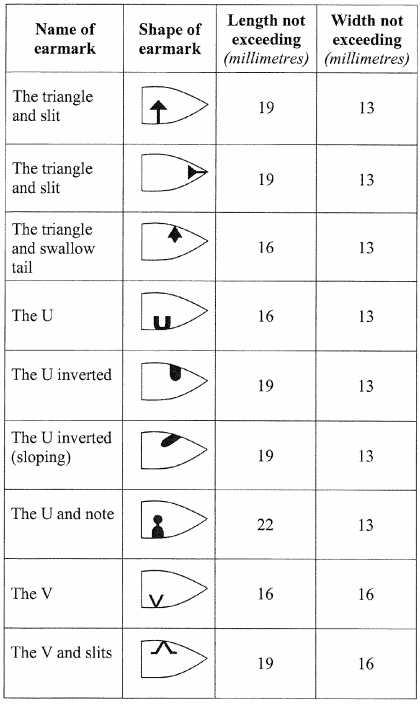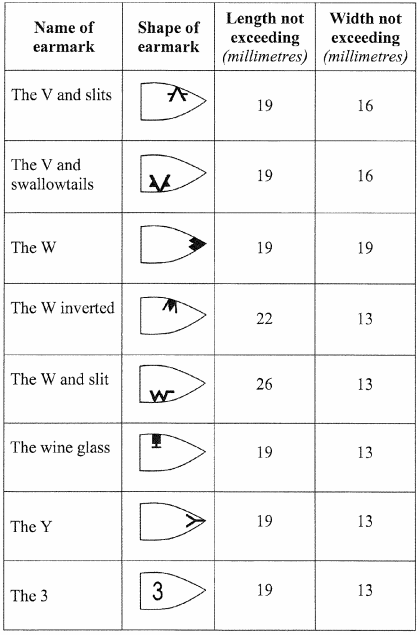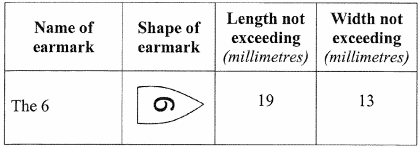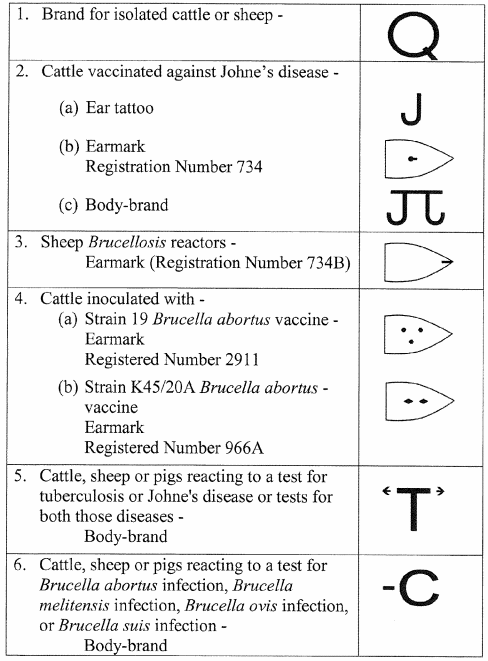Animal (Brands and Movement) Regulations 2014
I, the Lieutenant-Governor in and over the State of Tasmania and its Dependencies in the Commonwealth of Australia, acting with the advice of the Executive Council, make the following regulations under the Animal (Brands and Movement) Act 1984 .
1 December 2014A. M. BLOW
Lieutenant-Governor
By His Excellency's Command,
JEREMY ROCKLIFF
Minister for Primary Industries and Water
PART 1 - Preliminary
These regulations may be cited as the Animal (Brands and Movement) Regulations 2014 .
These regulations take effect on 10 December 2014.
(1) In these regulations –[Regulation 3 Subregulation (1) amended by S.R. 2014, No. 154, Applied:01 Feb 2015] accredited meat premises has the same meaning as in the Primary Produce Safety (Meat and Poultry) Regulations 2014 ;Act means the Animal (Brands and Movement) Act 1984 ;establishment identification means a unique alphanumeric code issued by Meat & Livestock Australia Limited (ABN 39 081 678 364) and used to identify premises in reports to the NLIS database;[Regulation 3 Subregulation (1) amended by S.R. 2014, No. 154, Applied:01 Feb 2015]national vendor declaration number means the serial number printed on a national vendor declaration form issued by Meat and Livestock Australia Limited (ABN 39 081 678 364);NLIS database means the National Livestock Identification System database maintained by NLIS Ltd;NLIS Ltd means National Livestock Identification System Limited (ABN 34 134 745 038);NLIS number means either of the following unique numbers used to identify an animal within the NLIS database:(a) the number printed on the outside of the permanent identification device that is attached to, or inserted in, the animal;(b) the number encoded in the microchip contained within that device;property identification code means a unique code issued by the Registrar to identify a property;public scale operation means a public event to which cattle are delivered for assessment and possible sale to the holder of the event.(2) In these regulations, a reference to a form by a number is taken to be a reference to the form of that number set out in Schedule 1 .
PART 2 - Brands and Tags: Registration and Related Matters
4. Form of Register of Animal Brands and Tags
For the purposes of section 6(1) of the Act, the register is to be kept in either or both of the following forms:(a) print-outs produced by a computer;(b) documents produced otherwise than by a computer.
5. Cattle and sheep that do not have to be branded with registered earmarks
For the purposes of section 8(2) of the Act, the following classes of sheep and cattle are prescribed:(a) cattle that are registered as stud cattle by an organisation the primary function of which is the preservation, or improvement, of a specific breed of cattle;(b) sheep of which the pedigree for not less than 3 generations is kept by, or is in the possession of, the person in charge of the sheep;(c) ram lambs that are –(i) no more than 12 months of age; and(ii) intended for live export to a country that requires any sheep exported to it not to be branded with an earmark.
(1) For the purposes of section 10(1)(c) of the Act –(a) the pig must be branded with the registered body-tattoo so that the registered body-tattoo is clear and legible; and(b) the registered body-tattoo must be located on the pig's shoulder.(2) For the purposes of sections 10(1)(d) , 11(4) , 11 (5) and 21(4) of the Act, a body-tattoo or registered body-tattoo for a pig is to consist of no more than 3 letters of the English alphabet, each of which is in a typeface of at least 20 millimetres, but no more than 35 millimetres, high.
7. Nature and dimensions of earmarks for cattle and sheep
(1) For the purposes of sections 11(1) and 18(1)(a) of the Act, the earmark or registered earmark must be of the nature and within the dimensions specified in Schedule 2 .(2) The width of an earmark or registered earmark must not exceed the length of the earmark.
8. Nature and dimensions of body-brands for cattle and sheep
(1) For the purposes of sections 11(2) , 11 (3) , 11 (5) , 19(1) and 21(4) of the Act, a body-brand or registered body-brand in respect of cattle and sheep must –(a) consist, for a cattle body-brand, of a chemical brand, fire-brand, or freeze-brand; and(b) consist, for a sheep body-brand, of a chemical brand or wool-brand; and(c) in the case of a body-brand that is yet to be registered under the Act, contain no more than 3 letters of the English alphabet; and(d) be constructed so that no part of the face of the brand is more than 7 millimetres wide; and(e) be at least 50 millimetres, but no more than 110 millimetres, high (unless it consists of a letter within a sign, in which case the body-brand may be up to 130 millimetres high).(2) In this regulation –chemical brand means a brand that is imposed on the skin of cattle or sheep by means of a depilatory substance on the skin;fire-brand means a body-brand that is intended to be burnt by a branding iron on the hide of cattle;freeze-brand means a body-brand that is imposed on the skin of cattle by means of an implement that has been subjected to a freezing process;wool-brand means a body-brand that is intended to be imprinted or imposed on the wool of sheep.
(1) For the purposes of sections 11(2) and 22(1)(b) of the Act, the tag or registered tag must be –(a) fully, or conditionally, accredited with NLIS Ltd; and(b) one of the following tags:(i) Allflex Original Button tag (with original male pin);(ii) Datamars ET32mm triangular cattle device;(iii) Datamars rumen bolus Z72 capsule (including matching visual ear tag);(iv) Leadertronic ear tag;(v) Leader ceramic rumen bolus capsule (including matching visual ear tag).(2) For the purposes of section 22(1)(a) of the Act, the registered tag is to be attached somewhere other than the ear that is required to be branded with a registered earmark under section 18(1) of the Act.(3) For the purposes of section 22(1)(c) of the Act, the particulars of identification for the tag or registered tag referred to in subregulation (1)(b) are the property identification code that identifies the property that the cattle to be tagged are from and the NLIS number for the cattle to be tagged.
10. Brands and tags: application for registration or transfer of rights
(1) A single application form may be used for the purposes of section 11 of the Act by the owner of any cattle or sheep who wants to obtain one or more of the following:(a) registration of an earmark for the purposes of section 18(1) of the Act;(b) registration of a body-brand or tag under section 9(1) or (3) of the Act;(c) in the case of cattle, registration of a tag under section 9(1) of the Act.(2) A single application form may be used for the purposes of section 13(1) of the Act if the proprietor referred to in that section wishes to transfer more than one right.
11. Fee for application for registration
For the purposes of sections 11(6)(e) and 13(3)(d) of the Act, the prescribed fee is 27 fee units.
12. Application in relation to registration
(1) For the purposes of section 12(1) of the Act, the certificate of registration is to be in accordance with Form 1.(2) For the purposes of section 13(5)(b) of the Act, the certificate of transfer is to be in accordance with Form 2.
13. Applications for issue of duplicate certificates
For the purposes of section 12(4) of the Act, the application for the duplicate certificate is to be –(a) in accordance with and contain the information required by Form 3; and(b) accompanied by a fee of 9 fee units; and(c) delivered or sent by post to the Registrar.
14. Preparations for branding sheep
For the purposes of section 20 of the Act, the prescribed preparation is a branding fluid containing a scourable dye.
A person must not, for the purpose of branding the ears of any cattle, use, or cause or permit to be used, a branding instrument that is so constructed that it removes more than one third of the ear.Penalty: Fine not exceeding 5 penalty units.
16. Branding for identification to prevent spread of disease, &c.
(1) The Chief Veterinary Officer may require the person in charge of any cattle, sheep or pigs to have them branded in the prescribed manner for the purposes of identification, if the Chief Veterinary Officer considers the branding necessary or desirable for the purposes of –(a) preventing the spread of a disease; or(b) facilitating the diagnosis of a disease; or(c) facilitating an investigation; or(d) facilitating the conduct of an experiment.(2) For the purposes of subregulation (1) , the prescribed manner is –(a) if subregulation (1)(a) , (b) or (c) applies, a manner directed orally, or in writing, by an inspector; or(b) if subregulation (1)(d) applies, a manner directed orally, or in writing, by the Chief Veterinary Officer.(3) A person who is required under subregulation (1) to have any cattle, sheep or pigs branded must comply with that requirement –(a) within such time as the Chief Veterinary Officer specifies when making the requirement; or(b) if no time is specified by the Chief Veterinary Officer, as soon as practicable after the requirement is made.Penalty: Fine not exceeding 5 penalty units.(4) A person who is required under subregulation (1) to have any cattle, sheep or pigs branded must, in complying with that requirement, ensure that the design of the brand applied to the cattle, sheep or pigs is –(a) in accordance with –(i) the appropriate design (if any) specified in Schedule 3 ; or(ii) the appropriate design registered in the name of the Department; and(b) if the requirement pertains to cattle or sheep, located on the left ear of a female and on the right ear of a male.Penalty: Fine not exceeding 5 penalty units.
17. Tagging cattle for slaughter or sale
(1) Subject to subregulation (2) or (3) , a person in charge of any cattle must ensure that they are each tagged for identification with the prescribed tag before they are taken, from the property where they are normally kept, to be –(a) [Regulation 17 Subregulation (1) amended by S.R. 2014, No. 154, Applied:01 Feb 2015] slaughtered, by a person who is the holder of a relevant accreditation under Part 4 of the Primary Produce Safety Act 2011 , in accordance with that accreditation; or(b) sold at a public saleyard.Penalty: Fine not exceeding 5 penalty units.(2) A person who purchases cattle that have been tagged in accordance with subregulation (1) is not required to retag those cattle under that subregulation for a sale or slaughter that occurs within 7 days after the date of that purchase.(3) If a person who is required to tag cattle under subregulation (1) with a prescribed tag –he or she may have the cattle tagged with an emergency tag.(a) is genuinely unable to tag the cattle with the prescribed tag; and(b) has been authorised by the Registrar to use an emergency tag –(4) The Registrar is to keep a record of all emergency tags obtained for the purposes of subregulation (3) .(5) In this regulation –emergency tag means a tag that contains –(a) the property identification code that identifies the saleyard or district that the cattle are from; and(b) a serial number issued by the Department that is unique to that tag;prescribed tag mean a tag applied in accordance with Schedule 4 .
18. Return of untagged or improperly tagged cattle
(1) If a person fails to comply with regulation 17(1) in respect of any cattle, an inspector may direct the person to return the cattle to the property where they were last normally kept, either immediately or within such time as the inspector specifies.(2) A direction under subregulation (1) may be given orally or in writing.(3) A person must comply with a direction given to the person under subregulation (1) .Penalty: Fine not exceeding 5 penalty units.
PART 3 - Procurement of Permanent Identification Devices and Prescribed Tags
In this Part –applicant, for a specified tag, means the person required under the Act to use that tag;NLIS authorisation means a number assigned to a person that indicates the person is authorised to order and use certain tags and devices for the purposes of the NLIS database;relevant identification number includes an NLIS authorisation and a property identification code;specified tag means –(a) a permanent identification device; or(b) a prescribed tag within the meaning of regulation 17 that is not a transaction tag within the meaning of Schedule 4 ;TAPDB means the Tasmanian Agricultural Property Database maintained by the Department, as amended or substituted from time to time.
20. Responsibilities of supplier of permanent identification devices and tags
(1) This regulation applies to –(a) a person who procures a specified tag, from its manufacturer, for sale to the applicant for that tag; and(b) the manufacturer of a specified tag.(2) A person to whom this regulation applies must not supply a specified tag for use by an applicant unless the person has verified that –(a) the property identification code to be included on the tag is the property identification code for the property owned, or operated, by the applicant; and(b) if details of the tag are to be entered in the NLIS database, that the NLIS authorisation provided to the person is the applicant's NLIS authorisation.Penalty: Fine not exceeding 5 penalty units.(3) For the purposes of subregulation (2) , a person verifies the information as required in that subregulation if the person confirms that the information provided to the person matches the information recorded on the following applicable databases:(a) the NLIS database;(b) the TAPDB.(4) The manufacturer of a specified tag must, when issuing the specified tag, upload to the NLIS database and the TAPDB any relevant information in relation to the tag.Penalty: Fine not exceeding 5 penalty units.
21. False or misleading information
(1) A person must not provide false or misleading information, including providing a false or misleading relevant identification number, to procure a specified tag.Penalty: Fine not exceeding 5 penalty units.(2) A person who is required to tag an animal with a specified tag must ensure that the specified tag is not false or misleading in a material particular before using the specified tag to tag the animal.Penalty: Fine not exceeding 5 penalty units.
PART 4 - Vendor Declarations and Movement Records
22. Vendor declarations for cattle, pigs, sheep and goats
(1) This regulation applies if –(a) there is a sale or other change of ownership of stock; and(b) the change of ownership involves a movement of stock from premises (in this regulation referred to as the place of origin) to other premises (in this regulation referred to as the destination); and(c) the destination has a different property identification code from that of the place of origin.(2) The person in charge of stock at a place of origin must, within 7 days after the day on which the stock are moved from the place of origin, provide a vendor declaration to –(a) if the destination of the stock is premises at which the stock are to be publicly auctioned, the person selling the stock on behalf of the vendor; or(b) in the case of any other destination, the person in charge of the stock at the destination.Penalty: Fine not exceeding 5 penalty units.(3) A person who provides a vendor declaration under subregulation (2) must –(a) state, in the vendor declaration, that the information provided in it is true and correct; and(b) sign the vendor declaration.Penalty: Fine not exceeding 5 penalty units.(4) The person in charge of the stock at the place of origin must keep a copy of a vendor declaration provided under subregulation (2) in good condition for at least –(a) if the vendor declaration is in respect of sheep or goats, 7 years; and(b) in the case of any other vendor declaration, 2 years.Penalty: Fine not exceeding 3 penalty units.(5) A person who is provided with a vendor declaration under subregulation (2) must keep the vendor declaration, or a copy of the vendor declaration, in good condition for at least –(a) if the vendor declaration is in respect of sheep or goats, 7 years; and(b) in the case of any other vendor declaration, 2 years.Penalty: Fine not exceeding 3 penalty units.(6) The Registrar, by notice in writing, may request a person who is required to keep a vendor declaration or copy of a vendor declaration under subregulation (4) or (5) to give the Registrar, within such period as is specified in the notice, a copy of the declaration, or a copy of the copy of the declaration.(7) A person who is given a notice under subregulation (6) must comply with the notice.Penalty: Fine not exceeding 3 penalty units.(8) In this regulation –purchaser means a person to whom stock are sold or ownership is otherwise transferred;stock means cattle, sheep, goats or pigs;vendor means a person selling or otherwise transferring ownership of stock;vendor declaration means a declaration, in an approved form, relating to a movement of stock for the purpose of a sale or other change of ownership, and specifying –(a) the name and address of the vendor; and(b) the name, address and telephone number of the person in charge of the stock at the place of origin (if not the vendor); and(c) the address and property identification code for the place of origin; and(d) whether or not the stock were born at the place of origin; and(e) the number of stock and a description that identifies their class by breed, age and sex; and(f) the name of the purchaser; and(g) the date on which the stock are moved from the place of origin; and(h) the address and property identification code for the destination; and(i) the name, address and telephone number of the person moving the stock (if not the vendor).
23. Movement records for sheep and goats not changing ownership
(1) This regulation applies if –(a) sheep or goats are moved from premises (in this regulation referred to as the place of origin) to other premises (in this regulation referred to as the destination); and(b) the destination has a different property identification code from that of the place of origin or no property identification code; and(c) the movement does not involve the sale or other change of ownership of the sheep or goats.(2) The person in charge of the animals at the place of origin must, within 7 days after the day on which the animals are moved from the place of origin, provide a movement record to –(a) the person in charge of the animals at the destination or, if no person is in charge of the animals at the destination, the owner or manager of the destination; and(b) the manager of the place of origin, if the person in charge of the animals at the place of origin is not the manager.Penalty: Fine not exceeding 5 penalty units.(3) The manager of the place of origin must keep a copy of the movement record provided under subregulation (2) –(a) as specified by the Registrar by notice in writing to the manager; or(b) in any other case, in good condition for at least 7 years.Penalty: Fine not exceeding 3 penalty units.(4) The owner or manager of the destination, unless exempted by notice in writing from the Registrar, must keep a movement record provided under subregulation (2) , or a copy of the movement record, in good condition for at least 7 years.Penalty: Fine not exceeding 3 penalty units.(5) The Registrar, by notice in writing, may request a person who is required to keep a movement record or copy of a movement record under subregulation (3) or (4) to give the Registrar, within such period as is specified in the notice, a copy of the document required to be kept under that subregulation.(6) A person who is given a notice under subregulation (5) must comply with the notice.Penalty: Fine not exceeding 3 penalty units.(7) In this regulation –movement record means a record, in an approved form, relating to a movement of sheep or goats for a purpose other than a sale or other change of ownership, and specifying –(a) the date on which the animals are moved from the place of origin; and(b) the name and address of the person in charge of the animals at the place of origin; and(c) the number of animals and a description that identifies their class by breed, age and sex; and(d) the property identification code for the place of origin; and(e) the address and, if there is one, the property identification code for the destination.
PART 5 - Reporting Cattle Movements to NLIS Database
24. Moving cattle from one property to another
(1) This regulation applies if –(a) cattle are moved from one property (in this regulation referred to as the property of origin) to another property (in this regulation referred to as the destination); and(b) the destination has a different property identification code from that of the property of origin.(2) The person in charge of the cattle at the destination must, within 7 days after the day on which the cattle arrive at the destination, provide the prescribed information to the NLIS database as required by the Registrar.Penalty: Fine not exceeding 5 penalty units.(3) For the purpose of subregulation (2) , the prescribed information is as follows:(a) the NLIS number of each animal;(b) the property identification code for the property of origin;(c) the property identification code for the destination;(d) if the movement involves a sale or other change of ownership and a national vendor declaration number is available for that transaction, that number;(e) the date on which the cattle arrive at the destination.(4) In this regulation –property means a feedlot, farm or other premises used for primary production of cattle, other than –(a) [Regulation 24 Subregulation (4) amended by S.R. 2014, No. 154, Applied:01 Feb 2015] accredited meat premises; or(b) a public saleyard; or(c) premises where a public scale operation is held; or(d) a showground;showground means premises where a public exhibition of cattle or a sporting event involving cattle is held.
25. Moving cattle to accredited meat premises
(1) [Regulation 25 Subregulation (1) amended by S.R. 2014, No. 154, Applied:01 Feb 2015] This regulation applies if cattle are moved to accredited meat premises for the purpose of slaughter.(2) [Regulation 25 Subregulation (2) amended by S.R. 2014, No. 154, Applied:01 Feb 2015] The person in charge of the accredited meat premises must, as required by the Registrar, provide the prescribed information about the cattle to the NLIS database by –(a) [Regulation 25 Subregulation (2) amended by S.R. 2014, No. 154, Applied:01 Feb 2015] for exempt accredited meat premises, the close of business on the fifth working day after the day of slaughter; and(b) [Regulation 25 Subregulation (2) amended by S.R. 2014, No. 154, Applied:01 Feb 2015] for all other accredited meat premises, the close of business on the working day immediately after the day of slaughter.Penalty: Fine not exceeding 5 penalty units.(3) For the purpose of subregulation (2) , the prescribed information is as follows:(a) the NLIS number of each animal;(b) the property identification code for the premises where each animal was last normally kept;(c) the date on which each animal was slaughtered;(d) [Regulation 25 Subregulation (3) amended by S.R. 2014, No. 154, Applied:01 Feb 2015] the establishment identification for the accredited meat premises;(e) [Regulation 25 Subregulation (3) amended by S.R. 2014, No. 154, Applied:01 Feb 2015] for accredited meat premises other than exempt accredited meat premises, the Hot Standard Carcase Weight of each animal slaughtered.(4) In this regulation –[Regulation 25 Subregulation (4) amended by S.R. 2014, No. 154, Applied:01 Feb 2015][Regulation 25 Subregulation (4) amended by S.R. 2014, No. 154, Applied:01 Feb 2015] exempt accredited meat premises means accredited meat premises that the Registrar, by instrument in writing, determines to be exempt accredited meat premises for the purposes of this regulation;Hot Standard Carcase Weight means the weight of the carcase, with fats removed, within 2 hours after slaughter.
26. Moving cattle to showground
(1) This regulation applies if cattle are moved to premises where a show or sporting event is held.(2) The person responsible for holding the show or sporting event must, as required by the Registrar, provide the prescribed information about the cattle to the NLIS database within 7 days after the close of the show or sporting event.Penalty: Fine not exceeding 5 penalty units.(3) For the purpose of subregulation (2) , the prescribed information is as follows:(a) the NLIS number of each animal;(b) the property identification code for the premises where the cattle were last normally kept before being moved to the relevant showground;(c) the property identification code for the relevant showground;(d) the property identification code for the premises to which the cattle will next be moved after leaving the relevant showground;(e) the date on which the cattle arrived at the relevant showground;(f) the date on which the cattle will be moved from the relevant showground.(4) In this regulation –relevant showground means premises where a show or sporting event is held;show means a public event involving an exhibition of cattle;sporting event means a rodeo, camp draft or other sporting event involving cattle.
27. Moving cattle to public cattle auction or public scale operation
(1) This regulation applies if cattle are moved to premises where a public cattle auction or public scale operation is held.(2) If the cattle are moved to premises where a public cattle auction is held, the person selling the cattle on behalf of their owner at the cattle auction must provide an arrival report about the cattle to the NLIS database within the specified time.Penalty: Fine not exceeding 5 penalty units.(3) If the cattle are moved to premises where a public scale operation is held, the person responsible for holding the public scale operation must provide an arrival report about the cattle to the NLIS database within the specified time.Penalty: Fine not exceeding 5 penalty units.(4) For the purposes of subregulations (2) and (3) , an arrival report is a report in an approved form that specifies the following:(a) the date on which the cattle are sold;(b) the NLIS number of each animal;(c) the property identification code for the premises where the cattle were last normally kept;(d) either the property identification code or the establishment identification for the premises where the public cattle auction or public scale operation is held;(e) if a national vendor declaration number is available for the sale, that number.(5) For the purposes of subregulations (2) and (3) , the specified time for an arrival report is as follows:(a) if the cattle are sold for slaughter, before the cattle leave the premises where the public cattle auction or public scale operation is held;(b) in any other case, by the close of business on the next working day after the day of the sale.
28. Moving cattle from public cattle auction or public scale operation
(1) This regulation applies if cattle are moved from premises where a public cattle auction or public scale operation is held.(2) If the cattle are moved from premises where a public cattle auction is held, the person selling the cattle on behalf of their owner at the cattle auction must provide a departure report about the cattle to the NLIS database within the specified time.Penalty: Fine not exceeding 5 penalty units.(3) If cattle are moved from premises where a public scale operation is held, the person responsible for holding the public scale operation must provide a departure report about the cattle to the NLIS database within the specified time.Penalty: Fine not exceeding 5 penalty units.(4) For the purposes of subregulations (2) and (3) , a departure report is a report in an approved form that specifies the following:(a) the date on which the cattle are sold;(b) the NLIS number of each animal;(c) either the property identification code or the establishment identification for the premises where the public cattle auction or public scale operation is held;(d) the property identification code for the next premises to which the cattle will be moved;(e) if a national vendor declaration number is available for the sale, that number.(5) For the purposes of subregulations (2) and (3) , the specified time for a departure report is as follows:(a) if the cattle are sold for slaughter, before the cattle leave the premises where the public cattle auction or public scale operation is held;(b) in any other case, by the close of business on the fifth working day after the day of the sale.
PART 6 - Miscellaneous
(1) An appeal under section 22C of the Act is to be instituted by a notice of appeal lodged with the clerk of petty sessions.(2) The notice of appeal is to specify the parties to the appeal and the grounds giving rise to the appeal.(3) On lodgement of the notice of appeal, the clerk of petty sessions is to –(a) cause a copy of the notice to be provided to the Minister; and(b) notify the parties to the appeal, in writing, of the time and place at which the appeal is to be heard.(4) The magistrate hearing the appeal, or a party to the appeal, may summon a person to appear and give evidence at the hearing of the appeal by causing that person to be served with a summons.(5) The magistrate hearing the appeal –(a) may adjourn the hearing from time to time or place to place as the magistrate considers appropriate; and(b) may inform himself or herself on any relevant matters in such manner as he or she considers appropriate; and(c) must proceed without undue formality; and(d) is not bound by the rules of evidence.(6) The hearing of the appeal is to be open to the public.(7) A party to the appeal may be represented at the hearing of the appeal by another person (whether an Australian legal practitioner or otherwise).
30. Infringement notice offences
For the purposes of section 29A(1) of the Act –(a) an offence against a provision of the Act or these regulations specified in column 2 of the table in Schedule 5 is a prescribed offence; and(b) the penalty specified in column 3 of that Schedule opposite that provision is the penalty applicable to that offence.
31. False or misleading statements
A person must not, in giving any information under these regulations –(a) make a statement knowing it to be false or misleading; or(b) omit any matter from a statement knowing that without that matter the statement is false or misleading.Penalty: Fine not exceeding 5 penalty units.
SCHEDULE 1 - Forms
Form 1
Form 2
Form 3
SCHEDULE 2 - Nature and dimensions of earmarks for cattle and sheep
SCHEDULE 3 - Designs of brands for cattle, sheep or pigs
SCHEDULE 4 - Tagging cattle for slaughter or sale
1. InterpretationIn this Schedule –AQIS means the Australian Quarantine and Inspection Service of the Commonwealth;EU-listed abattoir means an abattoir approved by AQIS to process meat for the European Union market;European Union Cattle Accreditation Scheme means the accreditation scheme of that name administered by AQIS;Departmental HGP tag means a yellow self-adhesive wrap-around tail tag at least 195mm long and 25mm wide including a unique identification number issued by the Department;HGP transaction tag means one of the following tags:(a) a yellow self-adhesive wrap-around tail tag at least 195mm long and 25mm wide;(b) a yellow plastic ratchet tail tag at least 25mm wide;(c) a yellow plastic ear tag at least 57mm long and 40mm wide;hormonal growth promotants means a veterinary chemical product containing a substance that is, or a mixture of substances that are, responsible for oestrogenic, androgenic or gestagenic activity to enhance growth or production in bovines or bubalines;transaction tag means a tail tag or an ear tag other than –(a) a permanent identification device; and(b) an emergency tag referred to in regulation 17(3) .
2. Prescribed tagsFor the purposes of regulation 17 , the tags specified in this Schedule in relation to cattle of a kind are the prescribed tags for cattle of that kind.
3. Calves(1) [Schedule 4 Amended by S.R. 2014, No. 154, Applied:01 Feb 2015] This clause applies to calves under 6 weeks old that are unaccompanied by their dam and being sent directly to accredited meat premises.(2) A prescribed tag for a calf to which this clause applies is one of the following tags:(a) a white plastic ear tag approximately 75mm long and 11mm wide showing the property identification code for the property where the cattle were last normally kept;(b) a permanent identification device approved under the NLIS for cattle.
4. Cattle accredited under the European Union Cattle Accreditation Scheme(1) This clause applies to cattle accredited under the European Union Cattle Accreditation Scheme that are being sent for slaughter at an EU-listed abattoir or for sale at an AQIS-accredited saleyard.(2) A prescribed tag for cattle to which this clause applies is a permanent identification device accepted under the European Union Cattle Accreditation Scheme.
5. Mature bulls (NLIS identified)(1) This clause applies to mature bulls that –(a) are identified with a permanent identification device accredited by NLIS for cattle; and(b) [Schedule 4 Amended by S.R. 2014, No. 154, Applied:01 Feb 2015] are to be sent directly to accredited meat premises for slaughter; and(c) have been, or may have been, treated with hormonal growth promotants.(2) A prescribed tag for bulls, to which this clause applies, is an HGP transaction tag.(3) A permanent identification device referred to in subclause (1) , that is used to identify a bull to which that subclause applies, must be registered on the NLIS database to show the property identification code for the property where the bull was last normally kept.
6. Mature bulls (not NLIS identified)(1) This clause applies to mature bulls that are –(a) not identified, with a permanent identification device accredited by NLIS for cattle, because they are dangerous; and(b) [Schedule 4 Amended by S.R. 2014, No. 154, Applied:01 Feb 2015] to be sent directly to accredited meat premises for slaughter.(2) A prescribed tag for a mature bull, to which this clause applies, is –(a) one of the following transaction tags, including a unique identification number, issued by the Department:(i) a blue self-adhesive wrap-around tail tag at least 195mm long and 25mm wide;(ii) a blue plastic ratchet tail tag at least 25mm wide; and(b) if the mature bull has been, or may have been, treated with hormonal growth promotants, a Departmental HGP tag.
7. Any other cattle(1) This clause applies to any cattle not otherwise specified in this Schedule.(2) The prescribed tags for cattle to which this clause applies, are –(a) a permanent identification device approved under the NLIS that is registered on the NLIS database to show the property identification code for the property where the cattle were last normally kept; and(b) if the cattle have been, or may have been, treated with hormonal growth promotants, an HGP transaction tag or a Departmental HGP tag.
SCHEDULE 5 - Infringement notice offences
Column 1 | Column 2 | Column 3 | Provision | Penalty units | 1. | Section 8(1) | 0.5 | 2. | Section 10(1) | 0.5 | 3. | Section 11(13) | 0.5 | 4. | Section 11(14) | 0.5 | 5. | Section 11(15) | 0.5 | 6. | Section 15(1) | 0.5 | 7. | Section 16 | 0.5 | 8. | Section 18(1) | 0.5 | 9. | Section 18(3) | 0.5 | 10. | Section 18(4) | 0.5 | 11. | Section 19(1) | 0.5 | 12. | Section 20(1) | 0.5 | 13. | Section 20(3) | 0.5 | 14. | Section 21(1) | 0.5 | 15. | Section 22(1) | 0.5 | 16. | Section 22FA(2) | 1 | 17. | Section 22G(2) | 1 | 18. | Section 22G(3) | 1 | 19. | Section 22G(4) | 1 | 20. | Section 24(7)(a) | 0.5 | 21. | Section 24(7)(b) | 0.5 | 22. | Section 27(1) | 0.5 | 23. | Section 27(2) | 0.5 | 24. | Section 27(5) | 0.5 | 25. | Section 27(7) | 0.5 | 26. | Section 27(9) | 0.5 | 27. | Section 30(2) | 0.5 | 28. | Regulation 17(1) | 0.5 | 29. | Regulation 20(2) | 0.5 | 30. | Regulation 20(4) | 1 | 31. | Regulation 21(1) | 1 | 32. | Regulation 21(2) | 0.5 | 33. | Regulation 22(2) | 0.5 | 34. | Regulation 22(7) | 0.5 | 35. | Regulation 23(2) | 0.5 | 36. | Regulation 23(6) | 0.5 | 37. | Regulation 24(2) | 0.5 | 38. | Regulation 25(2) | 0.5 | 39. | Regulation 26(2) | 0.5 | 40. | Regulation 27(2) | 0.5 | 41. | Regulation 27(3) | 0.5 | 42. | Regulation 28(2) | 0.5 | 43. | Regulation 28(3) | 0.5 |
Displayed and numbered in accordance with the Rules Publication Act 1953.
Notified in the Gazette on 10 December 2014
These regulations are administered in the Department of Primary Industries, Parks, Water and Environment.


